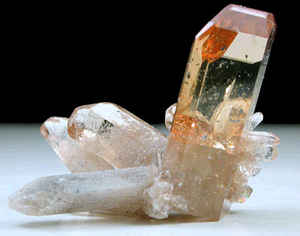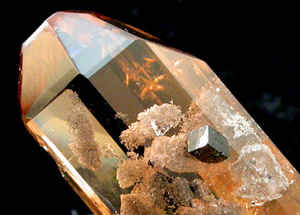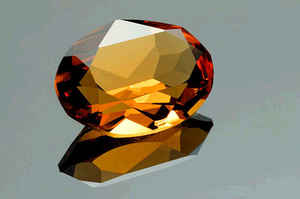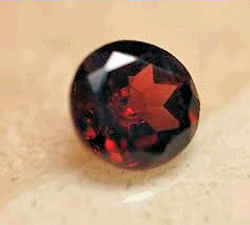

Utah Symbols
Utah State Gemstone or Gem
Topaz

Al2(OH,F)2SiO4 - Aluminium Fluosilicate
fluorine (F) and the hydroxyl (OH) can partly replace each other
Adopted on February 4, 1969 .
The Topaz became the State Gem on February 4, 1969. It is a semiprecious gem found in Beaver, Juab and Tooele counties of Utah. Small perfect cyrstals are found with quartz, hematite, bixbyite, garnet, pseudobrookite, amethyst, cristobalite, durangite, cassiterite and red beryl in cavities in rhyolite on Thomas Mountain, Juab County. Orange topaz, also known as precious topaz, is the traditional November birthstone, the symbol of friendship, and the state gemstone of the US state of Utah
Topaz: Utah State Gemstone or Gem

This hard gem is an aluminum fluorisilicate and is next in hardness to carborundum and diamonds (two of the hardest natural minerals around). Until the 1950s, topaz was generally known as a yellow or golden gemstone. Since then, routine radiation and heat treatment of pale-colored topaz to turn it blue has changed the modern public's perception of this gem. Constructed of atoms of aluminum, silicon, fluorine, and oxygen, topaz usually is colorless to pale blue or yellow - although pink stones can be produced by heating the golden brown topaz from Ouro Preto, Brazil.
Thomas Range topaz obtained their color from natural radiation during their formation in vent pipes which trapped volatile gases in cavities within the host rhyolites. When unearthed they glow with a vibrant sherry color and with exposure to direct sunlight for awhile will generally turn clear. The sunlight (also UV radiation) reacts with the color centers in the topaz crystal structure displacing electrons which in turn change the color. However, some locations do produce topaz that fade to a beautiful pink color. Some topaz are "tougher" than others and do not have as weak a cleavage plane as the Thomas Range topaz which usually they cleave with a flat top. A favorite location for the mineral collectors and rockhounds is called "The Cove" on the southern end of the Thomas Range.
Location: The Thomas Range is located in the west desert area of Utah approximately 40 miles NW of Delta Utah, in Juab county.
Age and composition: The Thomas Range is composed mainly of a series of five or more highly siliceous volcanic lava flows, known as rhyolite, that erupted 6-8 million years ago. The rhyolite, for the most part, is light gray in color and forms a series of dome-like structures. The rhyolite itself is not very uniform in hardness due to substantial amounts of late stage volcanic gases that differentially altered the rhyolite shortly after eruption. This variation in hardness causes the rock to weather with a 'honeycomb' like pattern that in some ways reminds one of Swiss cheese. It is within these hollowed out cavities that the minerals of interest occur. The rhyolites that make up most of the Thomas Range are known as topaz rhyolites. The name topaz rhyolite is given to rhyolitic rocks that are rich in late stage pneumatolitic components that are enriched in fluorine which then form topaz. The composition of the rhyolites of the Thomas Range are the extruded equivalents of a granite pegmatite.
Characteristics of Topaz

The topaz crystals at Topaz Mountain are naturally amber colored, but become colorless after exposure to sunlight. The crystals formed within cavities of the Topaz Mountain Rhyolite, a volcanic rock which erupted approximately six to seven million years ago (Tertiary Period) from volcanic vents along faults in the area.
- Crystal Description: Orthorhombic
Color- Varies from water clear to a rich sherry amber to light pink; some crystals (Maynard mine) are dichroic showing a dark amber color when vied perpendicular to the C axis and a deep cinnamon red color when viewed directly down the C axis. - Luster- Glassy
- Hardness- 8
- Specific Gravity- 3.5
- Cleavage- Perfect basal
NOVEMBER Birthstone: Topaz

Topaz the birthstone for November and the -4th Anniversary Gem, has been prized for several thousands of years in antiquity. Topaz can come in a variety of colors, but the prized Imperial Topaz, adored by Russian Czars, is orange with pink undertones. Named for an island, Topazos, in the Red Sea where the Romans found the gem, it has come to symbolize consistency, faithfulness and friendship and is believed to have calming and curative powers. It is also said to prove loyalty in friends and associates by changing colors in the presence of poison. During the Middle Ages, topaz was used to cure mental illness and was thought to delay death.
Utah Law
The law designating the topaz as the official Utah state gem is found in the Utah Statutes, Title 63, Chapter 13, Section 63-13-5.5.
TITLE 63. State Affairs in General.
CHAPTER 13. Miscellaneous Provisions.
SECTION 63-13-5.5. State Symbols.
63-13-5.5. State symbols.
(1) Utah's state animal is the elk.
(2) Utah's state bird is the sea gull.
(3) Utah's state centennial astronomical symbol is the Beehive Cluster located in the constellation of Cancer the Crab.
(4) Utah's state centennial star is Dubhe, one of the seven bright stars composing the Big Dipper in the constellation Ursa Major.
(5) Utah's state centennial tartan, which honors the first Scots known to have been in Utah and those Utahns of Scottish heritage, shall have a pattern
or repeating-half-sett of white-2, blue-6, red-6, blue-4, red-6, green-18, red-6, and white-4 to represent the tartan worn anciently by the Logan and
Skene clans, with the addition of a white stripe.
(6) Utah's state cooking pot is the dutch oven.
(7) Utah's state emblem is the beehive.
(8) Utah's state fish is the Bonneville cutthroat trout.
(9) Utah's state flower is the sego lily.
(10) Utah's state folk dance is the square dance, the folk dance that is called, cued, or prompted to the dancers and includes squares, rounds, clogging,
contra, line, and heritage dances.
(11) Utah's state fossil is the Allosaurus.
(12) Utah's state fruit is the cherry.
(13) Utah's state vegetable is the Spanish sweet onion.
(14) Utah's historic state vegetable is the sugar beet.
(15) Utah's state gem is topaz, as is prominently found in the Thomas Mountain Range in Juab County, Utah.
(16) Utah's state grass is Indian rice grass.
(17) Utah's state hymn is "Utah We Love Thee" by Evan Stephens.
(18) Utah's state insect is the honeybee.
(19) Utah's state mineral is copper.
(20) Utah's state motto is "Industry."
(21) Utah's state railroad museum is Ogden Union Station.
(22) Utah's state rock is coal.
(23) Utah's state song is "Utah This is the Place" by Sam and Gary Francis.
(24) Utah's state tree is the blue spruce.
Minerals, & Gems

Gemstone, Minerals, Rocks





